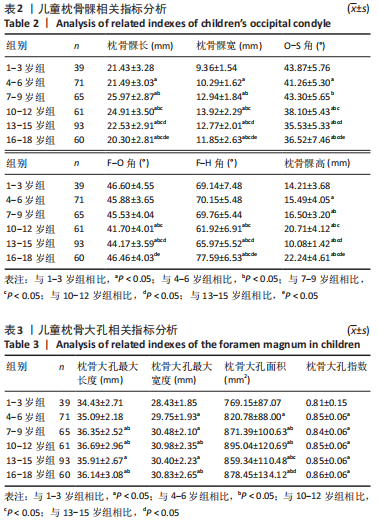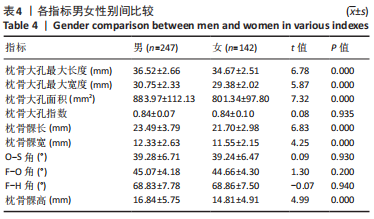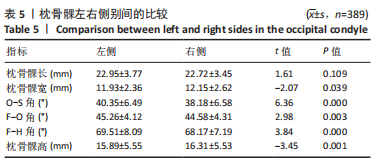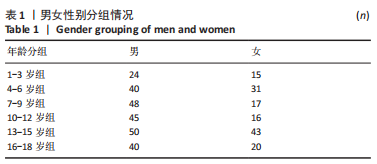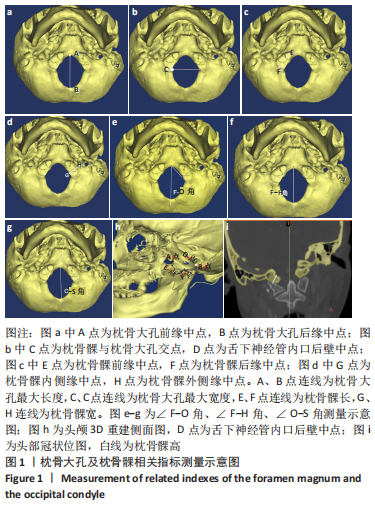中国组织工程研究 ›› 2024, Vol. 28 ›› Issue (18): 2830-2834.doi: 10.12307/2024.028
• 数字化骨科 digital orthopedics • 上一篇 下一篇
儿童枕骨髁及枕骨大孔数字化测量的临床意义
李 琨1,2,周哲源3,王 建1,张 燕3,赵 岩3,何学桐3,李 轲3,陈思敏3,吴星雨3,王 星1,2,张少杰1,2
- 1内蒙古医科大学基础医学院解剖学教研室,内蒙古自治区呼和浩特市 010110;2内蒙古医科大学数字医学中心,内蒙古自治区呼和浩特市 010059;3内蒙古医科大学鄂尔多斯临床医学院,内蒙古自治区呼和浩特市 010110
Clinical significance of digital measurement of occipital condyle and foramen magnum in children
Li Kun1, 2, Zhou Zheyuan3, Wang Jian1, Zhang Yan3, Zhao Yan3, He Xuetong3, Li Ke3, Chen Simin3, Wu Xingyu3, Wang Xing1, 2, Zhang Shaojie1, 2
- 1Department of Anatomy, School of Basic Medicine, Inner Mongolia Medical University, Hohhot 010110, Inner Mongolia Autonomous Region, China; 2Digital Medicine Center, Inner Mongolia Medical University, Hohhot 010059, Inner Mongolia Autonomous Region, China; 3Erdos Clinical Medical College, Inner Mongolia Medical University, Hohhot 010110, Inner Mongolia Autonomous Region, China
摘要:
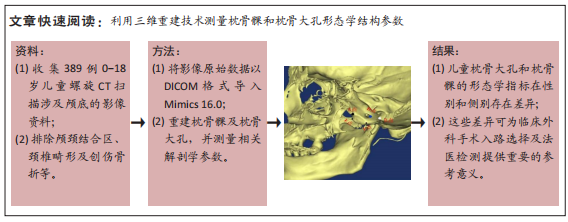
文题释义:
枕骨髁:为枕骨侧部下方的椭圆形关节面,是颅骨和脊柱的关键连接枢纽。枕骨大孔:位于枕骨的前下部,其内部有多对颅神经、椎动脉及脊髓前后动脉等重要结构通过。
背景:由于儿童年龄较小,枕骨髁和枕骨大孔尚未发育完全,容易发生枕颈交界区的各种疾病与创伤,严重时需手术治疗。但目前缺乏对儿童枕骨髁和枕骨大孔发育的解剖学参数。
目的:利用三维重建技术对枕骨髁和枕骨大孔形态学结构进行相关测量,为枕颈交界区病变以及相关外科手术和法医鉴定提供重要的解剖学参数。方法:收集行螺旋CT扫描涉及颅底的原始儿童及青少年影像资料389例,其中男247例,女142例,年龄1-18岁。按照年龄分为1-3岁组、4-6岁组、7-9岁组、10-12岁组、13-15岁组和16-18岁组。利用Mimics 16.0软件三维重建颅底,测量枕骨大孔长度和宽度,并且利用公式计算出枕骨大孔面积和指数,测量枕骨髁长度、宽度、高度,枕骨髁长轴与矢状轴的夹角(O-S角),枕骨大孔前、后缘中点连线与枕骨髁后缘和枕骨大孔交点连线的夹角(F-O角),枕骨大孔前、后缘连线中点与舌下神经管后壁中点连线的夹角(F-H角)。对各指标间进行性别、侧别和年龄差异分析。
结果与结论:①枕骨大孔测量除枕骨大孔指数不存在性别间的显著性差异(P > 0.05)外,枕骨大孔最大长度和最大宽度、枕骨大孔面积均存在性别间差异(P < 0.05);②枕骨髁的O-S角、F-O角和F-H角在性别间无显著性差异(P > 0.05),枕骨髁长、枕骨髁高、枕骨髁宽在性别间差异(P < 0.05);③枕骨髁长在侧别间无显著性差异(P > 0.05),枕骨髁高、枕骨髁宽、O-S角、F-O角和F-H角在侧别间差异均有显著性意义(P < 0.05);④枕骨大孔最大长度和最大宽度、枕骨大孔面积、枕骨髁长、枕骨髁高和枕骨髁宽随着年龄的增长呈波浪状递增的趋势;而O-S角、F-O角和F-H角随着年龄的增长呈波浪状递减趋势;枕骨大孔指数则无明显变化;⑤提示儿童枕骨大孔和枕骨髁的形态学指标在性别和侧别间存在差异,这些差异可为临床外科手术入路选择及法医检测提供重要的参考意义。
https://orcid.org/0000-0002-8329-3368 (李琨)
中国组织工程研究杂志出版内容重点:人工关节;骨植入物;脊柱;骨折;内固定;数字化骨科;组织工程
中图分类号:
